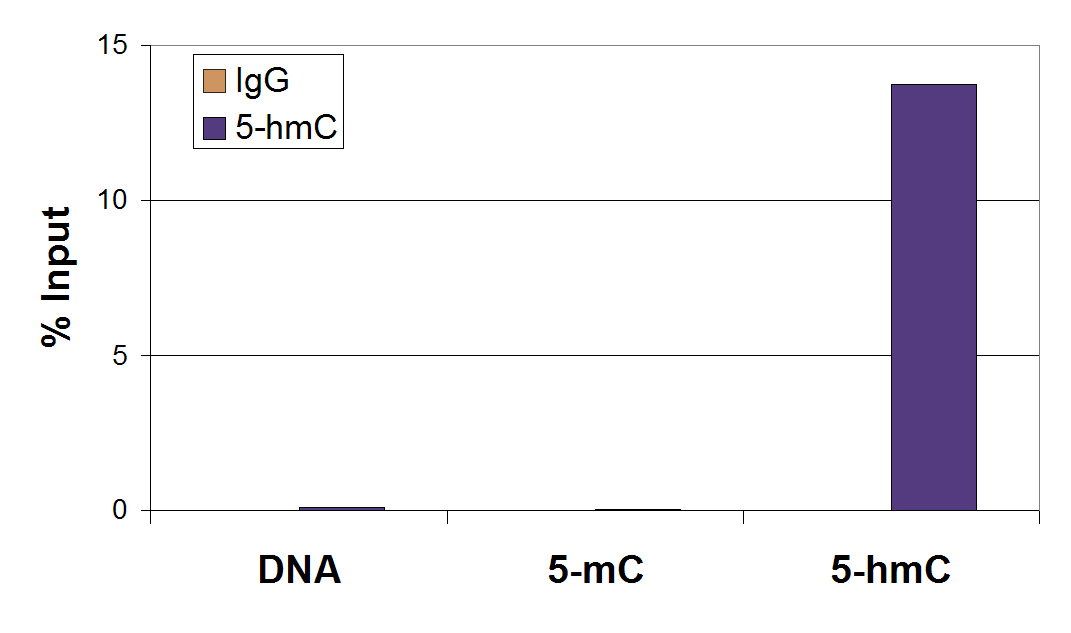5-Hydroxymethylcytosine (5-hmC) antibody (mAb) (Clone 59.1)
Host / Isotype
Mouse / IgG2a
Reactivity
Human, Mouse, Not Species Specific
Applications
IF, IHC, Dot Blot, ICC, MeDIP
CloneNo.
59.1
Cat No : 39999,40000,40900 39999
Synonyms
验证数据展示
产品信息
| Tested Applications |
IF, IHC, Dot Blot, ICC, MeDIP
Applications Validated by Active Motif: MeDIP: 1 - 2 ug per IP MeDIP-chip: 10 ug per IP DB: 0.2 mg/ml dilution |
| Tested Reactivity | Human, Mouse, Not Species Specific |
| Host / Isotype | Mouse / IgG2a |
| Class | Monoclonal |
| Type | Antibody |
| Modification | Methylated |
| Immunogen | This 5-Hydroxymethylcytosine antibody was raised against 5-hydroxymethylcytidine conjugated to KLH and recognizes 5-hydroxymethylcytosine. |
| Full Name | 5-Hydroxymethylcytosine (5-hmC) antibody (mAb) (Clone 59.1) |
| Synonyms | 5-Hydroxymethylcytidine, 5-hydroxymethylcytosine, 5-hmC, 5-Hydroxy methylcytidine, 5-hydroxy methyl cytidine, 5-hydroxymethylcytosine, 5-hmc, 5 hmc, 5hmc, hydroxy methyl cytosine, Hydroxymethylcytosine, Hydroxy methylcytosine, Hydroxy methyl cytosine, monoclonal, antibody, antibodies, mAb, epigenetics, epigenetic, hydroxy methyl cytosine, hydroxymethyl, 5-hydroxy-methyl-cytidine, hydroxy-methyl-cytosine, hydroxy-methylcytidine, DNA methylation, clone 59.1, medip, sample |
| Molecular weight | |
| GenBank accession number | N/A | RRID | AB_2566808 | Purification Method | Protein G Chromatography |
| Buffer | Purified IgG in 70 mM Tris (pH 8), 105 mM NaCl, 31 mM glycine, 0.07 mM EDTA, 30% glycerol and 0.035% sodium azide. Sodium azide is highly toxic. |
| Storage | Some products may be shipped at room temperature. This will not affect their stability or performance. Avoid repeated freeze/thaw cycles by aliquoting items into single-use fractions for storage at -20°C for up to 2 years. Keep all reagents on ice when not in storage. |
背景介绍
In addition to this monoclonal, Active Motif offers two polyclonal antibodies that recognize 5-hydroxymethylcytosine, a whole serum version (39769) and a purified IgG version (39791).All are validated for use in methyl DNA immunoprecipitation (MeDIP). For customers that require the ability to quantitate the amount of IgG in the MeDIP reaction, we recommend either this monoclonal or the purified IgG polyclonal (39791). The whole serum version (39769) is very high titre and should be used carefully (0.1 - 0.5 ul per IP) as not to generate high non-specific background. The whole serum version (39769) has been used successfully in immunofluorescence (IF, Ito et al, 2010), and the purified IgG version (39791) is likely to work in this application as well. DNA methylation is an epigenetic event in which DNA methyltransferases (DNMTs) catalyze the reaction of a methyl group to the fifth carbon of cytosine in a CpG dinucleotide. This modification helps to control gene expression and is also involved in genomic imprinting, while aberrant DNA methylation is often associated with disease. 5-methylcytosine is a modified base that is found in the DNA of plants and vertebrates. A second type of DNA methylation exists, 5-hydroxymethylcytosine (5-hydroxy methylcytosine, 5-hmC). This results from the enzymatic conversion of 5-methylcytosine into 5-hydroxymethylcytosine by the TET family of cytosine oxygenases. This antibody was developed specifically to distinguish 5-hydroxymethylcytosine from 5-methylcytosine as conventional methods (enrichment by antibody or methyl DNA binding protein, enzymatic digestion and bisulfite sequencing) cannot do so. It is possible that 5-hydroxymethylcytosine (5-hmC) represents a pathway to demethylate DNA, as 5-hydroxymethylcytosine is repaired as mismatched DNA and replaced with unmethylated cytosine.




